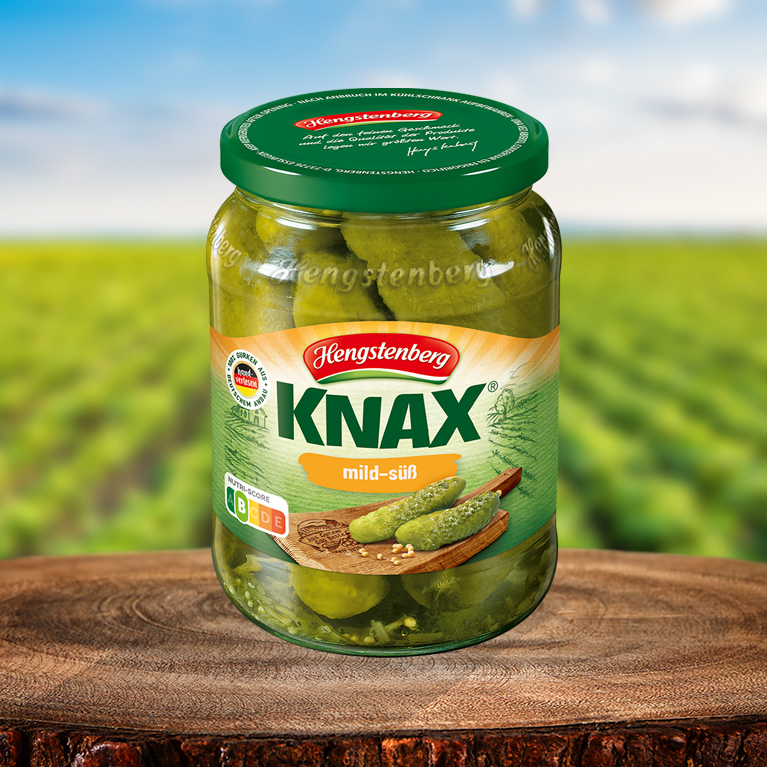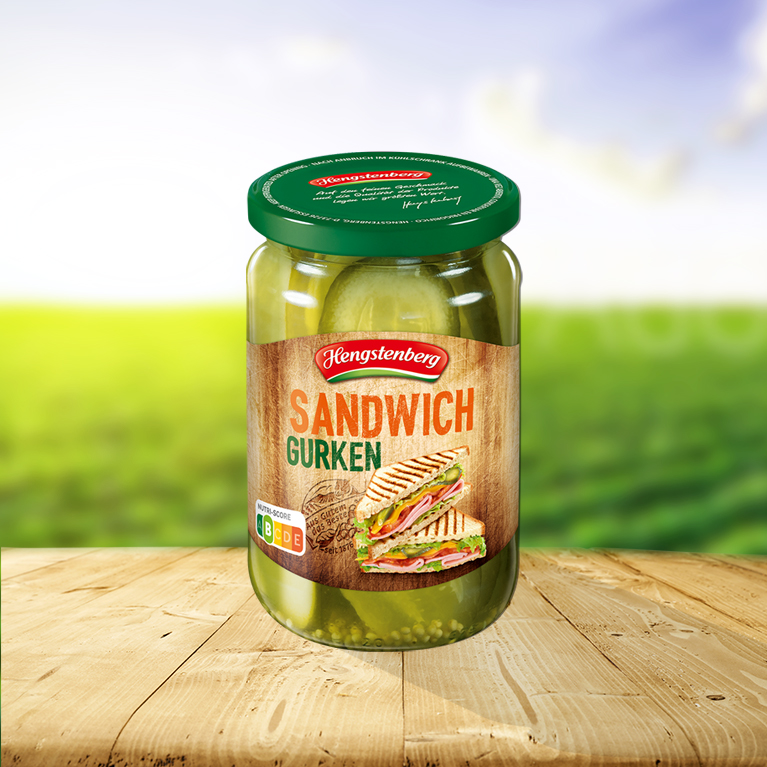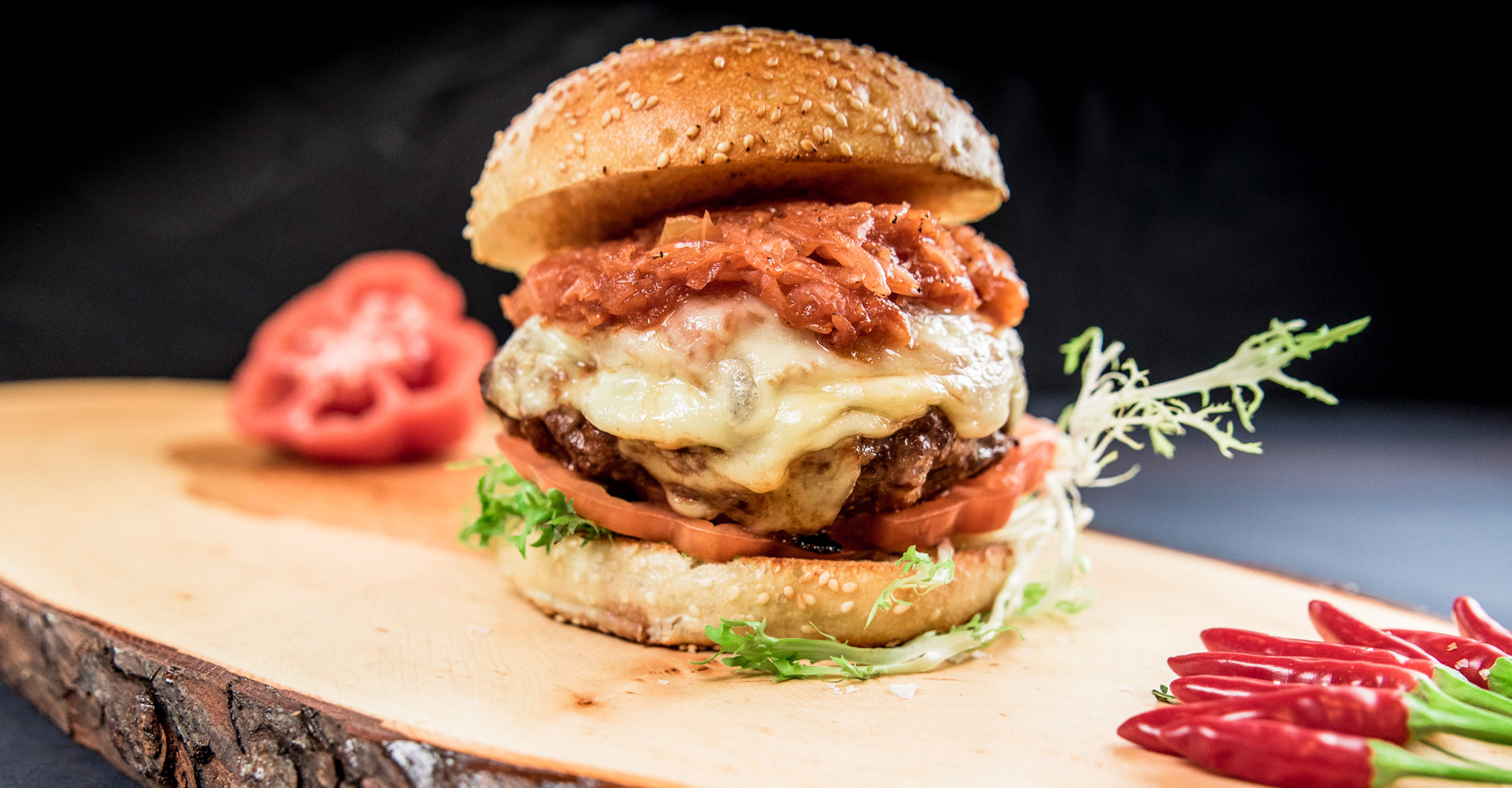The gherkin (Cucumis sativus) - like the cucumber - originally comes from India. It is not possible to say exactly when the popular gherkins first landed on European plates. However, it is known that pickled gherkins were already appreciated in Roman antiquity - precisely because of their long shelf life, but certainly due to their taste. Some sources claim that even the Egyptian queen Cleopatra was very fond of the small, crunchy gherkins.
All about gherkins
Whether you say pickles, or pickled gherkins, this article tells you how they get from the field to the jar - and where they grow in the first place. You will also find out whether pregnant women really have a greater appetite for pickled gherkins and which dishes are boring without them - in fact, everything you need to know about gherkins.

A short prologue
We love gherkins! That's why - and because there's a lot to say about them - we're dedicating a whole page to the crunchy little pickles!
By the way, others seem to feel the same - all over the world. Americans celebrate them too, on “National Pickle Day”.
We'll tell you everything you need to know about cornichons (a little further down on this page), gherkins and pickles in jars.
Even the Romans ate pickles
Which types of pickled gherkins exist? Are there any differences?
In fact, there are different types of pickled gherkins, which vary significantly in their preparation.
- The first type, our classic gherkins, are made with an infusion of vinegar, water and spices. Because they are pasteurised, i.e. strongly heated, they have a long shelf life.
- The second option, which is also very common all over the world, is often called sour pickles or salted gherkins: These, on the other hand, are fermented using lactic acid - similar to sauerkraut. They are usually pickled in a salt brine and thus preserved.
The gherkins differ in taste: The vinegar infused gherkins taste sweet & sour, while gherkins in salt brine taste more salty & sour.
From the field to the jar: gherkin cultivation
The gherkin, which is much smaller than the cucumber, usually grows outdoors without a trellis. Gherkin plants produce both male and female flowers. Once the flower has been pollinated, fruits will grow. With more modern breeds, pollination is not necessary because the plants produce purely female fruits. Exactly, fruits - because the gherkin, like the tomato, is a fruit. But how does the fruit get from the field into the jar?
From small seeds to crunchy gherkins
The gherkin seeds arrive in the fields as early as mid-April, where they can grow and flourish in the open air. It takes about 50 days for a small seed to grow into a crunchy gherkin.
Gherkins from German farming
We have relied on gherkins from German farming at Hengstenberg for many decades. Our long-term contract farmers select their types from the list of varieties we provide, and after that we source and distribute the seeds.
From mid-April, the young plants are spread out in the fields, where they can grow and thrive outdoors. It takes around 50 days for the small seed to grow into a plant with crunchy gherkin fruits. Depending on the weather, the fruits on the plant grow at different speed and each plant is harvested every few days during the gherkin season.
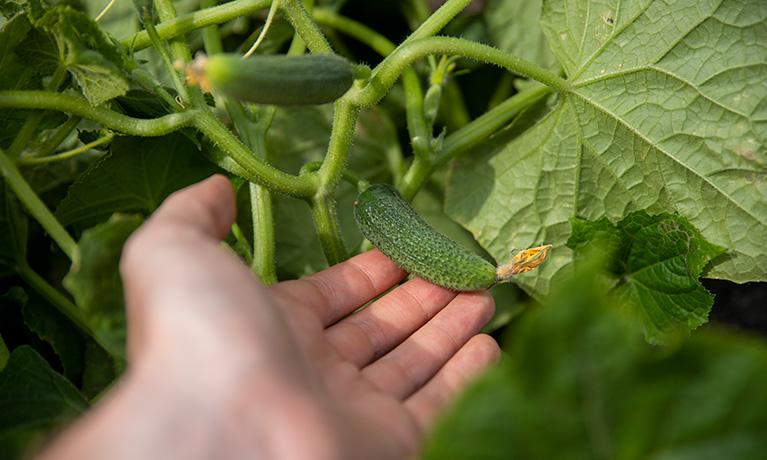


Time to put the gherkin in the jar
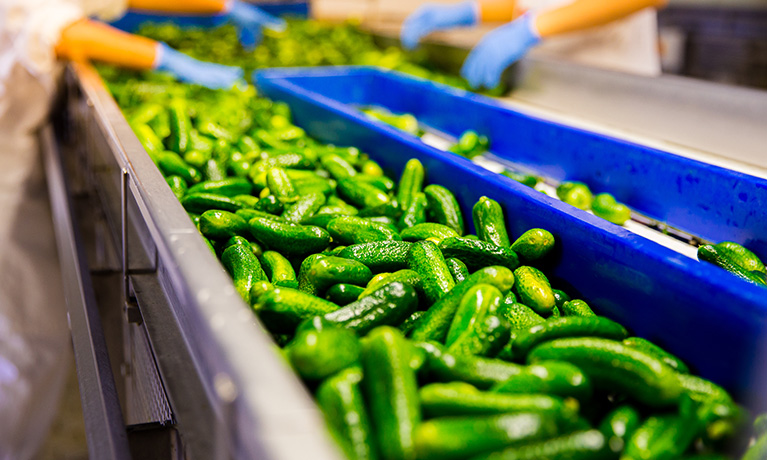
When the fresh gherkins arrive at our factory, they first get a bath. Then employees sort the gherkins according to size:
"It's important that the gherkins are neither too big nor too small, because after all they have to fit into the jar provided and should be as equal in size as possible."
This is followed by the quality check, where the watchful eyes of our experienced staff inspect the gherkins to make sure they are of good quality. Next, the gherkins are put into their jars, along with an infusion of vinegar with traditional spices and herbs.
The jars are then pasteurised, which means that we heat them gently so that they can be stored for a very long time - without any preservatives - and are available all year round.
During the pasteurization process, our gherkins not only remain perfectly crunchy, but their ingredients, such as vitamins and minerals, are also largely preserved.
After two weeks of storage, they developed their tangy flavour and are ready to enjoy.

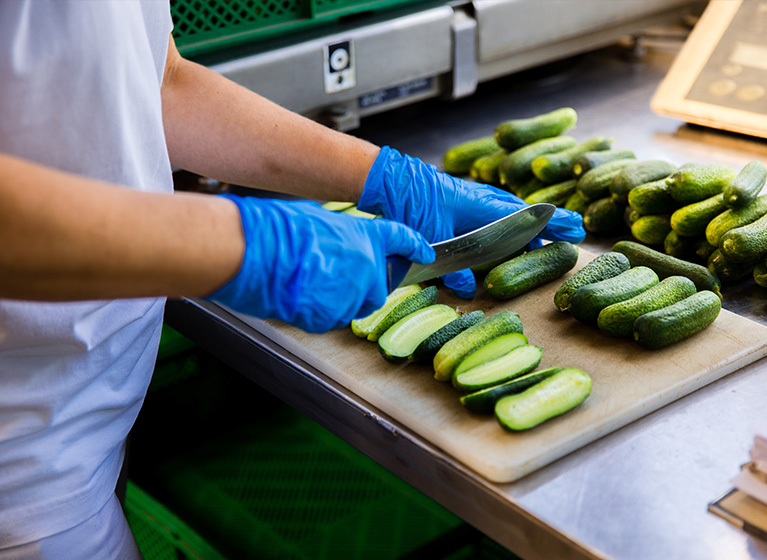

Our definition of "fresh from the field into the jar”
Most of our contract farmers grow their gherkins close to the factory - for us, this means that there is a distance of around 20 kilometres between the field and the factory. This is how we fulfil our motto "Fresh from the field into the jar". These short distances are important to us. Because this way we can produce sustainably, the gherkins get freshly pickled and absorb the flavour of the vinegar infusion intensively.
When is pickle time?
The harvest season of gherkins usually starts during the month of June. Of course, the climate is largely responsible for the timing.
Depending on the weather conditions, our farmers have a lot to do: Warm temperatures make the small fruits grow quickly. For this reason, the gherkins must be harvested fast, so they do not grow too big. Especially with the precious cornichons, timing plays a major role.
At Hengstenberg, the gherkin season usually ends by the end of August. Until then, the entire year's supply - until the next harvest in the following year - is produced.
So, while for many people summer is a rather relaxed time, gherkin production is running at full speed at Hengstenberg.

Gherkins are popular all over the world
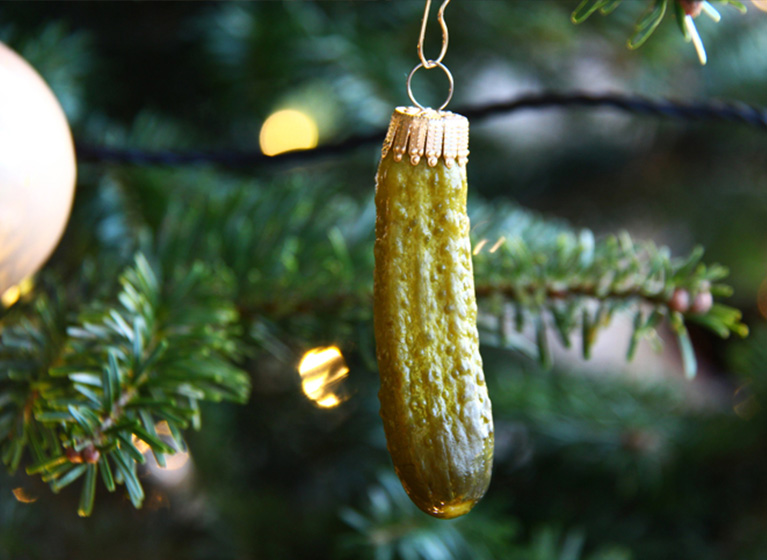
The Christmas pickle in the US
The USA produces 405,000 tons of pickled gherkins every year, which puts them on first place worldwide. On 14 November, the US celebrates "National Pickle Day". Another popular and established tradition follows at Christmas time: when Americans hang the beloved pickle on their Christmas tree as a Christmas decoration.
Usually, parents hide a Christmas pickle made of glass in the Christmas tree.
Depending on the interpretation of the tradition, the person who discovers the pickle ornament first has special luck: for example, they get to unwrap presents first or receive an extra gift.
The funny thing for us: many Americans think that this tradition is originated and very common in Germany. In reality however, the Christmas pickle is largely unknown here - much to our regret.
Popularity in Poland
Just as Americans love their pickles, Poles love their salted fermented gherkins. Polish pickled gherkins are often seasoned with dill, coriander and refined with a subtle hint of garlic. Gherkins taste particularly good in a Polish potato salad, mainly because of their aromatic garlic flavour, along with potatoes, onions, peas, apples, celery, carrots, eggs, mayo, mustard and pepper.
Cornichons - the French and their gherkin lift
Cornichon is French and basically means little horn, best describing their shape. Cornichons are smaller than conventional gherkins - but are comparable in taste.
When the jar of cornichons is nearing its end, people in Germany poke around with a fork or reach deep into it with their fingers. The French help themselves in a more elegant way: with an “ascenseur de cornichons”, a gherkin lift. It is a stick on a plastic disc with holes. The disc is under the cornichons, while the stick is at the opening of the jar. They can now easily lift their cornichons to the top and enjoy to the last bite.
Typical recipes that don't work without gherkins
Did you know that every German eats an average of 1.3 kg of pickled gherkins per year? Actually, it's not surprising because gherkins add a delicious and special touch to many dishes.
Without gherkins, some recipes would be like Ernie without Bert - they're only half as much fun to enjoy.
Potato salad: A classic German Christmas tradition
Let's start with a classic example: potato salad. The best potato salad is usually made by grandma. And many Germans eat potato salad on Christmas Eve. And yet no one would ever think of making a mayonnaise-based potato salad without tangy, crunchy gherkins.
A real burger must be topped with pickles
Our opinion: Anyone who picks the pickle off a burger (or avoids it from the start) is not a real burger lover. It is simply a must on a good burger. By the way: The restaurant Louis' Lunch in New Haven in the US state of Connecticut claims to be the oldest hamburger restaurant. It was founded in 1895 by immigrant Louis Lassen and has been serving hamburgers ever since.
Lobscouse, a typical Nordish dish, tastes delicious with fried egg and gherkins
Lobscouse is a potato dish with beef, rollmops (pickled herring fillets) and beetroot. It was first mentioned by the British author Ned Ward in 1706 and originally made of cured meat. Sailors often suffered from scurvy and could not eat their ration of meat because of their aching teeth. So, they came up with the idea of mashing it. Beetroot and gherkins are rich in vitamin C, which prevents scurvy. This is how the Lobscouse was born, which includes fried egg and pickled gherkins. The pickled gherkins harmonize wonderfully with the flavour of the beetroot and make the lobscouse a very special dish.
Gherkins belong in the “Wurstsalat”
Another speciality that is very popular in southern Germany, Alsace, Switzerland and Austria: the “Wurstsalat” (literally sausage salad). And of course, gherkins are a must-have ingredient. The sliced sausage is mixed with vinegar, oil and onions. The aromatic pickled gherkins perfectly round off the taste of this traditional meal, which is often eaten as a main course with just a slice of good bread.
You cannot miss gherkins or Danish cucumbers on hot dogs
Even if the Swedish furniture giant might make you think so, hot dogs are not from Sweden. The soft bun, which contains a sausage (bockwurst), sweet and sour gherkins, fried onions, mayonnaise, mustard and ketchup, actually comes from Germany – namely Frankfurt am Main. The butcher Johann Georg Hehner is said to have invented a precursor to the hot dog in 1847.
Authentic beef roulades need bacon and gherkins
Roast or roulades are a dish for special occasions in Germany. They are served with potatoes and red cabbage or sauerkraut. Roulades come from the 18th/19th century, and the word comes from the French “roulade” from the verb “rouler”, which means to roll. And that's exactly what roulades are all about: spread thinly sliced beef with mustard, put bacon and gherkins on top and roll up, fry, cook - and enjoy.
Simply a perfect snack or topping of your sandwich
A delicious snack or sandwich is often hearty, particularly tasty and simply comforting. Whether during breaks, as breakfast or in the evening, on their own or on a tasty cheese or sausage sandwich, pickled gherkins add just the right amount of extra flavour and perfect balance.
Once you have eaten all the gherkins...
...you should never throw away the pickle juice. You can not only pickle new gherkins with it, but also use it for other things.
Need some examples?
- For sports enthusiasts: Gherkin infusion helps against cramps.
- Cooking: Refine dressings, dips or marinate/tenderize meat with it.
- Cleaning: Makes copper shine again and great for descaling.
- Gardening: To fertilise lilies, primrose or lupines (they love acidic soil) or as a weed killer
Do pregnant women eat more gherkins and do they help against a hangover?
Do pregnant women really crave gherkins?
No, it is a myth. Pregnant women eat just as many gherkins as non-pregnant women. According to a Dutch study, only 8% of the pregnant women surveyed had cravings for gherkins. The fact that women suddenly eat foods during pregnancy that they didn't like before - or suddenly don't like their favourite food - is due to hormonal changes. So, it can sometimes happen that a pregnant woman suddenly feels a craving for gherkins.
Why gherkins can help against hangover
If you've had too many drinks at a party, it can help to eat gherkins for your hangover breakfast the next morning. After drinking alcohol, the body craves acidity, salt and spiciness. All these components are combined in gherkins.
Did you got a craving for gherkins and want to try some recipes with them? Feel free to stop by our recipe section and inspire yourself.





